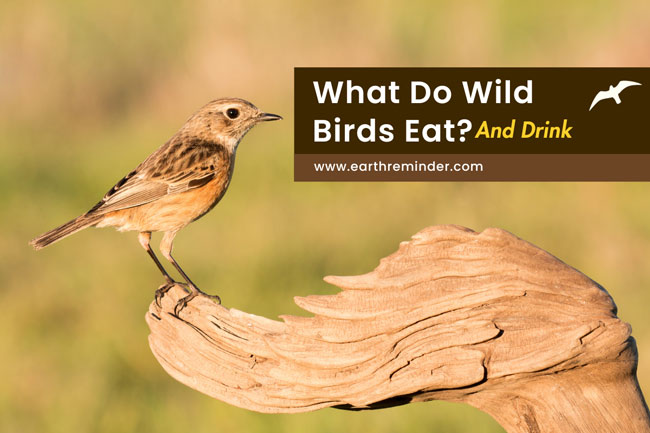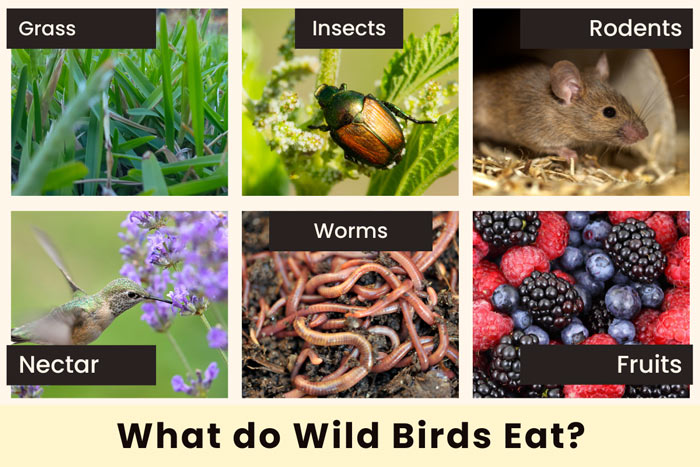When you’re watching birds fly around, do you ever wonder what they eat? Well, we’ve all been there! Each bird has a different eating choice. Several birds enjoy the delicacies in bird feeders, but some also eat various things in the wild. The few who typically eat from garden bird feeders gradually tend to move to natural food sources. But, what do wild birds eat and drink, then? In the wild, birds typically consume seeds, nectar, grubs, worms, and insects. Others feed on snakes, rodents, small animals, and all those little birds, although some birds eat berries, fruits, nuts, grass and pollen. It also depends on where they live and what season it is. Here, we will go deeper into the diet of wild birds.
Table of Contents
What Do Birds Eat In The Wild?
Some species of birds only consume plants, but others are omnivorous or carnivorous. The size and form of their beaks, which enable them to forage for particular kinds of food, similarly impact their diet. For birdwatchers, bird enthusiasts, and conservationists alike, knowing what wild birds eat is crucial since it helps identify the species and their biological function in their habitat. Diet of wild birds come from the following sources:
Seeds and Nuts
Birds such as sparrows, finches, and pigeons eat seeds and nuts. For example, sparrows often eat the seeds of weeds and grasses. Finches may eat sunflower seeds. They eat nuts from trees too. They’re high in nutrients and can be found in many places.
In the Winter: Wild birds rely largely on seeds and nuts for daily sustenance during the winter. Some of the most common seeds eaten by wild birds include sunflower, millet, as well as thistle seeds. Throughout the winter, wild birds can also get a lot of energy from nuts including almonds, hazelnuts, as well as peanuts.
Nectar
Hummingbirds are famous for drinking nectar. Several other birds, including sunbirds and honeyeaters, also consume nectar. Their beaks are shaped specifically so they can get nectar from the inside of flowers. They get energy from nectar.
Grubs and Worms
Robins and blackbirds are good at finding grubs and worms in the soil. When they see worms, they use their beaks to dig them out. The protein in worms helps these birds remain strong.
Insects
Swallows, swifts, and flycatchers catch flies and mosquitoes as they fly. The woodpecker pecks at the bark of trees to find insects such as ants and beetles. A lot of habitats have insects, which are a good source of protein for birds.
In the Winter: Although they might not appear to be a typical winter food source, insects are still present as food for wild birds at this time of year. A significant source of protein for wild birds, certain insect species and their larvae could survive the winter.
Snakes and Rodents
Birds of prey such as eagles, hawks, and owls eat larger animals. For example, a bald eagle might catch a snake and carry it back to its nest. Mice are often hunted by owls at night. There is a lot of protein in the meat of these animals.
Small Animals
Sometimes, falcons and larger owls eat other small animals, like squirrels, or small birds such as sparrows. Their beaks and claws are strong, which helps them to catch and eat their food. It helps their bodies to stay strong so they can fly.
Fruits
Birds like cardinals, blue jays, and orioles eat berries from bushes, and fruits like apples and cherries. Birds get vitamins from them and can easily find them compared to moving prey.
In the Winter: Fruits and berries are another crucial food source for wild birds throughout the winter. These fruits give the birds the essential vitamins and minerals they need to be healthy. Wild birds frequently consume apples, blueberries, cranberries, and other fruits.
Pollen and Grasses
There are doves and specialized birds like the “Kakapo parrot” in New Zealand that eat grasses and flower pollen directly. It’s not as high in protein, but it still has other nutrients.
Besides the above diet, if you have wild birds in captivity or zoo such as starlings, woodpeckers, chickadees, and nuthatches, you can give them suet in moderation. Suet is a high-energy snack made from animal fat, almonds, and seeds. It’s a favorite food source for wild birds during the winter because it gives them energy to endure the cold. You can buy suet cakes and blocks at pet stores and supermarkets.
“Birds do more than eat and drink, they contribute to the health of the planet earth as well. Find out why are birds important to the environment.”
What do Wild Birds Drink?
Like people and other creatures, wild birds also drink water. Birds, conversely, cannot get their water from the food as numerous other animals can; thus, they must drink water on their own to be hydrated. Wild birds drink from the following sources:
- Ponds and Lakes: Ducks, geese, and swans are often seen drinking from ponds, lakes, and rivers.
- Rainwater: A lot of small birds like sparrows and robins drink rainwater collected in leaves or small puddles.
- Morning Dew: Birds may drink the dew that forms on leaves in the morning, especially in drier areas.
- Watering Holes: There are certain places in deserts and savanna ecosystems where birds drink water, such as watering holes. You might see birds visiting these locations.
- Human-Made Sources: Pigeons and starlings are often seen drinking from fountains, birdbaths, and even artificial swimming pools that humans have built.
- Birds can drink from fast-moving streams and rivers.
- Birds in the desert might peck at a cactus to get to the moist inside when the ground is really dry.
Birds may turn to drinking from sources not usually available, including animal footprints or even uncommon human-made sources like leaking pipes or gutters, in places where water is limited. To support the survival of wild birds, it is crucial to ensure that these sources are clean and loaded with fresh water.
“If you’re concerned about bird population declines and want to go beyond feeding birds and actually save them, check out how to save birds from radiation and extinction.”
Conclusion
Wild birds have different eating habits that are affected by their ecological environments, species characteristics, and seasons. Although some birds are mainly frugivores, insectivores, or carnivores, but others are seed eaters.
A lot of avian species eat these foods, along with nectar, small animals, and even carrion. Finches and sparrows are examples of seed-eating birds, which consume a range of seeds, such as thistle, millet, and sunflower seeds.
Insectivorous birds, like swallows, eat insects like flies, beetles, or mosquitoes. Birds that consume fruit, such as figs, include thrushes and tanagers.
Some birds have long, slender bills designed for sucking nectar from flowers, such as hummingbirds and honeyeaters. Meanwhile, raptors such as eagles and hawks mainly eat smaller birds, fish, and other tiny animals, including rodents.
In a nutshell, wild birds’ diverse and adaptable diet allows them to flourish in the wild. The weather, migration patterns, and food availability all play a role in their diet. So, the next time you hear a bird singing in the trees or see one flying in the sky, you’ll know what it might be searching for.

